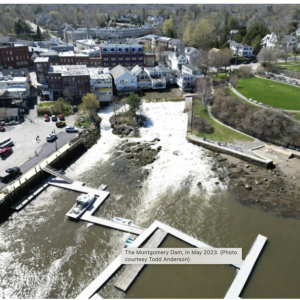Camden awaits federal word on funding to help remove Montgomery Dam
On June 10, Camden citizens voted 1,391 to 995 to remove the Montgomery Dam and spillway at the head of Camden Harbor, with the caveat that the project's fiscal responsibility would not fall on property owners through local taxation.
"The Town is authorized to fund the work only from non-property tax revenue sources, e.g. grants and private donations; and 2) Any portion of the project impacting Harbor Park shall be subject to the approval of the Library Board of Trustees as stipulated in the deed of gift from Mary Louise Curtis Bok to the inhabitants of the Town of Camden...." the town's June Town Meeting Warrant Article 7 read.
Funding for the dam's removal is currently being pursued through two grant applications, one with the National Oceanic and Atmospheric Administration's (NOAA) Restoring Fish Passage through Barrier Removal program, the other through the National Fish and Wildlife Foundation's Coastal Resilience Fund.
Camden had applied for the NOAA grant by that federal agency's deadline of Feb. 10, and submitted its NFWF application on July 17. The town hopes to be hearing from NOAA later in the autumn.
NOAA said at its website that, "up to $75 million in funding is available for fish passage projects under the Bipartisan Infrastructure Law."
"NOAA Fisheries is reviewing applications and we do not have a timeline for decisions at this time," said Andrea Gomez, NOAA Communications Specialist and Public Affairs Officer, who is based in Gloucester, Massachusetts. NOAA does not provide information about submitted grant applications, saying they are pre-decisional, confidential, and/or contain business identifiable information and proprietary information.
At its grant website, NOAA said the earliest anticipated start date for awards will be January 1, 2026. "Often, we provide an announcement slightly earlier than that," the agency said. "But cannot anticipate exactly when that announcement will be."
The Camden grant applications each ask for financial help of approximately $6 to $7 million for the project, said Camden Town Manager Audra Caler.
The NOAA grant application cites the objective to remove the town-owned Montgomery Dam and redesign the adjacent Harbor Park shoreline, with the goal of reducing, "flood risk for adjacent properties during extreme rain events and prevent frequent overtopping and costly rebuilding of the connected sea wall. This, the application said, is a "critical first step in the restoration of fish passage throughout the Megunticook Watershed and represents the culmination of extensive community engagement and a watershed wide analysis that began in 2017. These efforts are consistent with recommendations from the 2021 Megunticook River Fish Passage and Flood Resilience Feasibility study."
The town discussed the larger Megunticook River goals in the NOAA grant application:
"Funding for dam removal at the watershed's lowermost barrier will allow upstream private property owners to move forward with plans to remove three more dams immediately upstream (Knox, Knowlton, and Powder Mill dams)," the NOAA application said. "Ultimately, the project will restore over 1,500 acres of lake and pond habitat for alewives, river herring, and American eels, as well as open access to 12-15 miles of tributary streams for sea run and resident wild eastern brook trout."
The National Fish and Wildlife Foundation grant application has a similar scope.
"The project employs dam removal to restore natural river and floodplain function and a hybrid approach between grey and green infrastructure for the historic, Olmsted Brothers designed, Harbor Park sea wall," the application.
Dwayne Shaw, director of the statewide Downeast Salmon Federation, said his nonprofit has also submitted a $4 million grant application with the National Fisheries and Wildlife Foundation's Transformational Habitat Restoration fund to remove the privately owned Knox and Knowlton dams. The owners of those dams were receptive to the Salmon Federation's initiative to apply for the funding, he said.
To Shaw, removal of the Camden dams furthers the Foundation's overall coastal goal to free the flow of rivers and streams from dams for the sake of thriving fish habitat.
"Most rivers around Penobscot Bay have been dammed in some way," he said. "The result has been the blockage of fish migration over the last 100 years."
The Federation works from Meddybemps in Washington County, to Camden. Its mission is "to conserve and restore wild sea-run fish and their habitats in Downeast Maine" and is "based on a vision of an abundant return of all sea-run fish species for the ecological, cultural, and economic benefit of the region and beyond."
Like Camden, the Federation is awaiting word about the status of its grant application and hopes to hear from the NFWF by November.
"We've been encouraged by what we hear from NOAA," he said.
Camden applications
Camden Town Manager Audra Caler said the town appreciates the collaborative approach to the river project.
"The goal was eventually not to be just a Town of Camden project," she said.
The $6.9 million NOAA application is entitled Megunticook River Barrier Removal and Harbor Resilience Improvements and lists several partnered entities, including Inter-Fluve, arestoration and water resources engineering firm; the environmental consulting firm Kleinschmidt; engineering company Gartley & Dorsky; and planners FB Environmental Associates.
The project is to, "dramatically reduce mortality of juvenile American eels as they attempt to access the Megunticook River during the annual elver run," the application said.
The application said elver harvesting is a lucrative fishery in Maine and the town-owned Montgomery Dam and Harbor Park seawall both contribute to eel mortality. Money received would also go for removing fish passage barriers at the former Brewster Shirt Factory, now the Knox Mill.
"This legacy wheel and weir system also creates a debris clogging hazard and increases the flood risk for the building," the application said.
In the application, Camden referenced the Maine Dept. of Marine Resources estimation that, "with full connectivity restored, the Megunticook River could have an annual run of 600,000 alewives, along with populations of other anadromous fish species such as blueback herring, American eel, brook trout, and white sucker."
Camden said the funding proposal is intended to address property under town control where critical repairs and improvements cannot wait. The proposal includes final design and permitting for fish passage and resilience improvements at two additional town-owned fish passage barrier locations.
"The East and West Megunticook Lake dams and the Seabright Dam are high hazard dams currently in the design phase for modification as part of work being funded by the NFWF/NOAA National Coastal Resilience Fund," the application said.
The Megunticook River Barrier Removal and Harbor Resilience Improvement Project, by "removing Montgomery Dam, strengthening Harbor Park, and adding fish passage to the upper town-owned dams—Seabright, East, and West—will restore the river’s natural flow, reconnect ecosystems, and reduce flood risks while making Camden’s waterfront more resilient," the application said.
Camden anticipates contributing matched funding of $500,000 through in-kind and administrative services.
"The Town of Camden has appropriated a minimum of $30k annually in the Town’s general fund budget specifically for habitat restoration related work as part of Town. ($90k for full award period).
"In kind services from the Town of Camden for oversight, administration, etc. The Town is not charging any indirect cost rate to the grant. Estimated value $400k over life of grant.
"During the construction phase, the Town can offer flagging, parking management, staging areas for contractors, heavy equipment operators, and incidental support to keep the project on track and reduce costs.
"Commission and other town committees: At least 100 volunteers are expected to participate at various stages for a total of at least 2000 volunteer hours, conservatively."
Camden is hoping to get the Montgomery Dam and harbor improvements completed between 2027 and 2028, with the bulk of activity taking place during Summer 2027, "when river flows are lower and after spring fish spawning runs," the NOAA application said.
Meanwhile, another infrastructure project in the same area of town, Maine Dept. of Transportation's $325,000 Main Street Bridge superstructure replacement, is outlined in the Maine Dept. of Transportation's 2025-2028 Statewide Transportation Improvement Program.
Camden Town Manager Audra Caler said in a phone conversation that the DOT plans to work on the Main Street Bridge in 2027, and communicates with the town about the Montgomery Dam removal project.
"The DOT knows about all of this and we have talked a lot about this," she said.
Details about the superstructure replacement are lean, and the DOT has yet to respond to queries about its Main Street Bridge project, aside from what is in the 2025-2028 transportation plan.
As the town pursues planning, permitting and contracting for the Montgomery Dam removal and landscaping in Harbor Park, it will remain in communication with the DOT.
"We would reach out to the DOT and see if possible to coordinate those projects," Caler said.
At the Aug. 19 meeting of the Camden Select Board, member Ken Gross said he met with Caler and Board Chair Susan Dorr about the grant applications, and asked how a general citizen or board member could contribute to the grant application and review process.
"I was told there is no way a citizen can contribute to a grant application review process," said Gross.
He suggested that process be addressed when the Select Board convenes to discuss its own internal bylaws and procedures.
Reach Editorial Director Lynda Clancy at lyndaclancy@penbaypilot.com; 207-706-6657




























